Launching a successful referral marketing campaign or scaling your program with referral software isn’t just about using your existing customers to gain new leads. With 74% of consumers identifying word-of-mouth as a key influencer in purchasing decisions and 92% of people ages 18 to 34 saying that they seek recommendations from friends and family before making a purchase, referral marketing is an integral component of today’s marketplace – and one that can yield impressive results if the right tactics are employed. Whether you’re wondering, “what is a referral marketing?” or looking for ways to scale, read on – we cover all of the components of referral marketing in this handbook.
With a well-built referral program (coupled with referral marketing software), you can actually increase brand loyalty among existing customers while simultaneously growing your customer base through referral traffic.
That’s a win-win.
Need more proof? Here are 8 referral marketing statistics that will change how you feel about this strategy.
Now, let’s talk about how to strategically get more referrals.
Referral Marketing Best Practices
If you want to take your referral program to the next level, here are 5 best practices to help you get there:
1. Your Referral Program Should Be Easy To Find

Don’t make your customers root around your website searching for a referral link. Or even worse, dig through their email to find out how to log into your portal and see their reward status. The harsh reality is people aren’t going to sign up for your referral program if they don’t know about it, so make sure you’re making it visible and prominent. Remember, the entire purpose of the program is to get people to spread the word about your brand, products and/or services. If signing up to do so is difficult and frustrating, you won’t get the results you’re hoping for.
2. Always Be Transparent

Now, more than ever, consumers are highly cautious about sharing their information – especially online. Make your customer referral program more attractive by being upfront and honest about the entire process. Let program members know how their information will be used, how they can keep track of the process and exactly what they’ll get in return. The more information you share about your program, the more at ease your customers will feel and the more likely they’ll be to sign on. And on the flip-side, collecting and analyzing data from customer referrals is critical for optimizing future rollouts and campaign iterations. You’re planning to enable your customers to share your brand with others, and in return, they’re going to enable you to better understand consumer behavior surrounding your products and services. The more you understand about your customer base and the leads they generate, the more efficiently you can hone referral marketing strategies, gain customer insight, and grow revenue. Don’t let this data slip away without tapping into its full potential. Before you launch a program, decide how you will collect, store, and examine the intel and data points you retrieve.
3. Know What Your Customers Want

If you want to entice people to share your brand with their own networks, you have to provide them with something of value in exchange. Knowing how to generate referrals from existing clients isn’t enough; do you know what they truly value? If your incentive isn’t worthwhile, your customer or B2B referral marketing program will never even get off the ground. A good incentive will provide some type of desirable reward for your existing customers while also equipping them to share an incentive with others. Consider what motivates people to buy your brand in the first place, and design a program that speaks to what customers really want. Sometimes recognition, such as being featured on the website or in an ad or blog post, can be equally as attractive as other types of incentives.
4. Ask At The Right Time

Your customers aren’t going to want to refer a friend if it’s the first thing you ask them to do. In fact, if you start an interaction by asking for a referral, you may lose the sale altogether. You have to wait until the right time. This is also where it can be very beneficial to have insight into how your prospects funnel through to become customers and the journey thereafter. Studies have shown that the moments following a shopping transaction – commonly referred to as a “shopper’s high” – are a highly effective time to ask for a referral, since the rush of the purchase is still lingering. Or, you might wait until after the customer has received the product or services and are satisfied. And not every incentive has to be directly linked to referrals. For example, are there ways that you can reward customers who make X or more purchases within a given timeframe? Offering free shipping, doubling rewards points, or providing additional discounts for your most loyal and enthusiastic customers is a great way to energize true word-of-mouth referrals.
5. Invest The Time And Resources Necessary

A successful customer referral program can become the lifeblood of your business, but it won’t do anything if it’s not backed by the proper resources. The program should be strategically planned out, regularly measured, and managed on an ongoing basis. When you invest in referral marketing automation for your program, you can see unimaginable growth through this marketing channel (just look at the ROI of referral marketing by different industries). You can’t achieve success if you’re treating your referral program as an afterthought. Successful programs need structure and commitment from within your company. For this reason, many brands choose automated and streamlined platforms to ensure ease and satisfaction from both a consumer and company perspective.
By implementing these best practices into your referral marketing strategy, you’ll be much more prepared to develop a program that will net the results you want without incurring too many roadblocks along the way.
Speaking of challenges, what about not-so-best practices?
While we routinely share referral marketing best practices, there are a handful of missteps we’ve come across that actually might be hurting your program more than you realize.
We wanted to shine a light on a few mistakes that almost always lead to poor results:
Mistake #1: Right incentive for you, wrong one for your customer
If your customers transact with you on a weekly or monthly basis, then it makes sense to incentivize referrals with account credits or discounts towards future purchases. However, if your customers purchase from you less than a few times per year, that reward won’t carry the same weight. In fact, it might send signals that you don’t really understand your customers.
For example, a free ride for referring a friend to Uber makes sense. But if Samsung gave their customers a $10 credit towards the purchase of their next TV, chances are their customers wouldn’t care to refer them.
So, what’s the right approach? If your customers transact only a few times during their lifecycle, you need to reward them with something of immediate value. Providing access to yet-to-be-released products can work, but cash and gift cards are virtually foolproof. In fact, a Nielsen Harris Poll found that 77% of Americans prefer to be rewarded for referrals with money.
Ultimately, for referral marketing to work, brands must be selfless. Focus on what’s right for your customers and give them a relevant reason to send you referrals today. If your referral incentives fail to provide immediate, tangible value, your program will fail, too.
Helpful tip: Dual incentives, where the customer and friend both receive a reward for a referral, are a proven way to accelerate sharing and drive purchasing behaviors. For a full breakdown of this incentive structure, check out The Definitive Guide to Building a World-Class Referral Program.
Mistake #2: A referral program that’s too complicated
Here’s an existential question to answer: If you have a referral marketing program in place and no one knows about it, does it really even exist?
If your referral program isn’t public facing or it’s difficult to use and share with the click of a button, then you’ll severely limit your ability to drive word-of-mouth and referrals. Also, if you’re requiring customers to manually input a potential referral’s information, good luck. For customers, this annoyance creates a barrier that significantly hinders referral activity.
How can you avoid that? Start by answering these questions:
– Where and when is it most likely that customers will want to share your brand/products?
– Are you requiring those customers to do the heavy lifting to find friends who might be interested in your company?
– Are you limiting your referral program to only current customers?
Here’s the bottom line: Make it simple for anyone (customers, fans, admirers, influencers advocates, etc.) to share your brand with everyone who might be interested in it.
Helpful tip: Like we mentioned before, ask for referrals at the point of purchase and after the first user experience. At this point, customer excitement (and the likelihood of referrals) is at its highest.
Mistake #3: Starting small with a half-hearted pilot
Over the last year, we’ve seen massive companies with millions of customers attempt to launch a referral program by testing it with just a few dozen or few thousand targeted customers. That “pilot” approach usually fails.
Here’s why: Just like converting web traffic into actual customers (and converting those customers into repeat buyers), referral marketing is a numbers game. It requires a funnel and, if you don’t put enough names into the top of that funnel, nothing will come out the bottom.
Another problem with this approach is that you don’t really know who your biggest fans and ambassadors are until you execute a referral marketing program at scale. When brands open up the program to everyone, amazing things happen. In some circumstances, people you wouldn’t expect to generate referrals end up being your best ambassadors.
Helpful tip: While it might seem to make sense to test first and scale later, that approach typically results in “test and fail.” A better strategy is to keep it simple by starting with two programs — one that’s public facing and incentivizes new shoppers to make their first purchase, and a second one that’s tailored specifically to existing customers.
The secret is to approach referral marketing just as you would any other high-value customer acquisition channel — investing in process and technology, and incorporating it into every aspect of your marketing strategy.
When you do that, the payoff can be huge.
